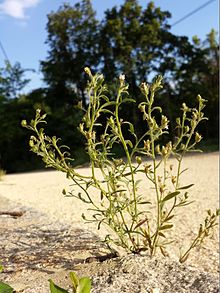Chaenorhinum minus
| Chaenorhinum minus | |
|---|---|

| |
| Scientific classification | |
| Kingdom: | Plantae |
| Clade: | Tracheophytes |
| Clade: | Angiosperms |
| Clade: | Eudicots |
| Clade: | Asterids |
| Order: | Lamiales |
| Family: | Plantaginaceae |
| Genus: | Chaenorhinum |
| Species: | C. minus
|
| Binomial name | |
| Chaenorhinum minus | |
| Synonyms | |
| |
Chaenorhinum minus, also known as small toadflax in Europe and dwarf snapdragon in the US and Canada, is a very diminutive member of the plant family Plantaginaceae.[1] It is native to continental Europe.[2]
Description[edit]
Chaenorhinum minus differs from many toadflaxes in having alternate leaves growing singly. Its leaves and sepals are covered with glandular hairs. Leaves are glaucous and sepals are green or purple. Flowers vary from pale purple to white. It is an annual herb, with a maximum height of 25 cm. It does not spread vegetatively.[3] Flowering occurs June–July.[4]
-
Chaenorhinum minus in a garden setting in the United Kingdom
-
a larger individual of Chaenorhinum minus in Austria
-
flower of Chaenorhinum minus in Germany
Habitat and distribution[edit]
It is such a small plant that it relies upon disturbance to compete with other plants for light. Once a common weed in farmers' fields, it has suffered from agricultural intensification and is now mainly seen in gardens and around railways, as well as roadsides and industrial sites.[5][6] Its UK distribution shows it favours chalky soil.
This species is native to continental Europe, found mainly in south and central Europe, though it reaches as far north as Sweden. It is considered to have 'archaeophyte' status in the United Kingdom ie. is thought to have been introduced many centuries ago.[7] It has also been introduced to the US and Canada.[8]
Taxonomy[edit]
There are considered to be four subspecies of Chaenorhinum minus:
- Chaenorhinum minus subsp. anatolicum P.H.Davis (Syn.: Microrrhinum minus subsp. anatolicum (P. H. Davis)NN): found in the Aegeans
- Chaenorhinum minus subsp. minus:
- Chaenorhinum minus subsp. idaeum (Rech. fil.) R.Fern. (Syn.: Microrrhinum minus subsp. idaeum (Rech. f.) NN): found in Crete
- Chaenorhinum minus subsp. pseudorubrifolium (Gamisans)NN (Syn.: Microrrhinum minus subsp. pseudorubrifolium (Gamisans)NN): found in Corsica
References[edit]
- ^ NatureGate - Small Toadflax
- ^ Online Atlas of the British and Irish Flora
- ^ Online Atlas of the British and Irish Flora
- ^ NatureGate - Small Toadflax
- ^ NatureGate - Small Toadflax
- ^ Online Atlas of the British and Irish Flora
- ^ Online Atlas of the British and Irish Flora
- ^ USDA - Chaenorhinum minus



